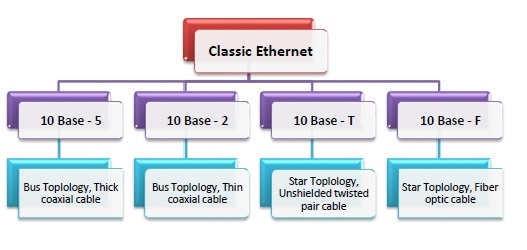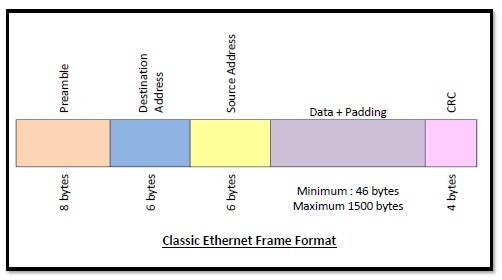
 Data Structure
Data Structure Networking
Networking RDBMS
RDBMS Operating System
Operating System Java
Java MS Excel
MS Excel iOS
iOS HTML
HTML CSS
CSS Android
Android Python
Python C Programming
C Programming C++
C++ C#
C# MongoDB
MongoDB MySQL
MySQL Javascript
Javascript PHP
PHP
- Selected Reading
- UPSC IAS Exams Notes
- Developer's Best Practices
- Questions and Answers
- Effective Resume Writing
- HR Interview Questions
- Computer Glossary
- Who is Who
Classic Ethernet
Ethernet is a set of technologies and protocols that are used primarily in LANs. It was first standardized in 1980s as IEEE 802.3 standard. Ethernet is classified into two categories: classic Ethernet and switched Ethernet.
Classic Ethernet is the original form of Ethernet that provides data rates between 3 to 10 Mbps. The varieties are commonly referred as 10BASE-X. Here, 10 is the maximum throughput, i.e. 10 Mbps, BASE denoted use of baseband transmission, and X is the type of medium used. Most varieties of classic Ethernet have become obsolete in present communication scenario.
Varieties of Classic Ethernet
The common varieties of classic Ethernet are -
Thick coax (10BASE-5): This was the original version that used a single coaxial cable into which a connection can be tapped by drilling into the cable to the core. The 5 refers to the maximum segment length of 500m.
Thin coax (10BASE-2): This is a thinner variety where segments of coaxial cables are connected by BNC connectors. The 2 refers to the maximum segment length of about 200m (185m to be precise).
Twisted pair (10BASE-T): This uses unshielded twisted pair copper wires as physical layer medium.
Ethernet over Fiber (10BASE-F): This uses fiber optic cables as medium of transmission.

Frame Format of Classic Ethernet
The main fields of a frame of classic Ethernet are -
Preamble: It is a 8 bytes starting field that provides alert and timing pulse for transmission.
Destination Address: It is a 6 byte field containing physical address of destination stations.
Source Address: It is a 6 byte field containing the physical address of the sending station.
Length: It a 7 bytes field that stores the number of bytes in the data field.
Data: This is a variable sized field carries the data from the upper layers. The maximum size of data field is 1500 bytes.
Padding: This is added to the data to bring its length to the minimum requirement of 46 bytes.
CRC: CRC stands for cyclic redundancy check. It contains the error detection information.


